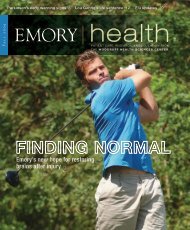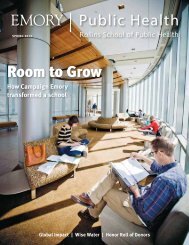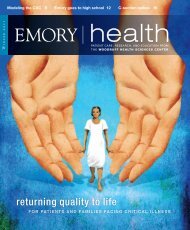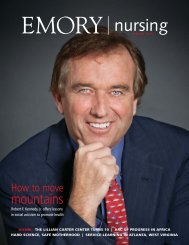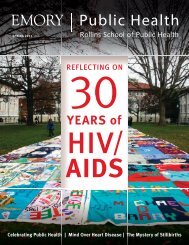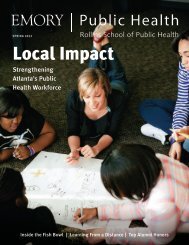medicine - Woodruff Health Sciences Center - Emory University
medicine - Woodruff Health Sciences Center - Emory University
medicine - Woodruff Health Sciences Center - Emory University
You also want an ePaper? Increase the reach of your titles
YUMPU automatically turns print PDFs into web optimized ePapers that Google loves.
In Brief<br />
Real-life lessons<br />
The patient winced with pain. A steel construction beam<br />
fell on his leg, and now he was in the hospital, asking the<br />
attentive medical team for a strong painkiller. He wanted<br />
morphine, and the team decided that prescribing the drug<br />
was the right course of action.<br />
If the patient had landed in<br />
a typical emergency room with<br />
stretched resources, he might not<br />
have had so many people attending<br />
to him. This patient was a<br />
mannequin in the experiential<br />
learning center, with third-year<br />
medical students and senior nursing<br />
students in attendance.<br />
It also was the first time in<br />
<strong>Emory</strong> history that both medical<br />
and nursing students trained<br />
together. Students were briefed<br />
on basic teamwork and skills<br />
and then ran through one of two<br />
scenarios: a 52-year-old construction worker with a leg<br />
injury or the same patient who later develops chest pain.<br />
Afterward, students talked about what worked and what<br />
didn’t with medical and nursing faculty who served as<br />
facilitators.<br />
One point the students learned: Don’t talk over the<br />
patient. Designate a team member to be the “explainer,” an<br />
TLC for damaged hips and shoulders<br />
Medical and nursing students practice teamwork<br />
in the experiential learning center.<br />
Used to be that total hip replacement was the best option<br />
for patients with arthritis of the hip. A new surgical procedure<br />
introduced recently to the United States offers a less<br />
drastic alternative for young, active patients with significant<br />
hip degeneration.<br />
Known as hip resurfacing, the surgery preserves more of<br />
the hip’s natural bone structure and provides a larger head<br />
ball, contributing to a more stable hip joint and potentially<br />
increased range<br />
of motion.<br />
Recovery is<br />
similar to total hip<br />
replacement, with<br />
most patients up<br />
and walking within<br />
24 hours of surgery<br />
with physical<br />
therapy, followed<br />
by a progressive<br />
increasingly important role as health care gravitates toward<br />
allowing family members to stay in the patient’s room.<br />
One nursing student liked how her team established a<br />
first-name basis with each other to put everyone on equal<br />
footing. “I liked it too,” added a<br />
medical student. “I didn’t walk<br />
into the room and think, ‘I’m the<br />
doctor and that’s the nurse.’ ”<br />
While all of the students<br />
learned valuable lessons that day,<br />
few medical and nursing schools<br />
incorporate team training into<br />
their curricula. And they’re<br />
missing a golden opportunity<br />
to improve patient care, says<br />
Douglas Ander, director of the<br />
<strong>Emory</strong> <strong>Center</strong> for Experiential<br />
Learning and an emergency<br />
<strong>medicine</strong> physician.<br />
“When health care teams<br />
are properly trained on how to work together, the result is<br />
better teamwork, reduced medical mistakes, and improved<br />
patient care,” says Ander. “The more time students train<br />
together at an earlier stage, the more it will be ingrained<br />
in their normal mode of operation. Typically, students and<br />
residents have little to no understanding of how teams<br />
function in a real health care environment.”—Kay Torrance<br />
increase in activity. “Most patients find that resuming a<br />
more normal, pain-free lifestyle occurs rapidly,” says <strong>Emory</strong><br />
orthopaedic surgeon Greg Erens.<br />
He cautions that the procedure isn’t for everyone.<br />
People with brittle bones, severe deformity of the hip, or<br />
dead bone or who are significantly overweight are not good<br />
candidates. In those cases, total hip replacement may be the<br />
best option.<br />
Another new technique is helping patients with rotator<br />
cuff injuries. The “double-row” arthroscopic repair<br />
allows the tendons around the shoulder joint to heal more<br />
dependably and lowers the risk of reinjury by securing the<br />
tendon to the bone at two sites rather than one.<br />
“It is much stronger than a typical ‘single-row’ repair<br />
and does a better job of restoring normal rotator cuff<br />
anatomy,” says Speros Karas of the <strong>Emory</strong> Sports Medicine<br />
<strong>Center</strong>. “Recent studies also show that the ‘double-row’<br />
repair heals in a more stable fashion, which results in better<br />
long-term outcomes.”<br />
Slowing down Alzheimer’s<br />
By 2040, some 81 million people worldwide are expected<br />
to have Alzheimer’s disease. School of Medicine scientists<br />
want to make sure that doesn’t happen.<br />
Neurologist Allan Levey is leading the first clinical trial<br />
of a new vaccine designed to slow Alzheimer’s progression.<br />
The vaccine targets the beta-amyloid protein that forms<br />
plaque and eventually damages brain cells.<br />
Previous research on<br />
genetically engineered<br />
mice found that vaccination<br />
with beta-amyloid at<br />
birth protects them from<br />
plaque formation and mental<br />
decline; older mice also<br />
showed some benefit from<br />
the vaccine.<br />
The Merck vaccine<br />
that Levey is testing uses<br />
a smaller piece of betaamyloid<br />
protein to stimulate<br />
antibody production<br />
but avoid stimulating T<br />
cells, the shock troops in<br />
an inflammatory response.<br />
Levey’s four-year study will<br />
evaluate vaccine safety,<br />
David Wright (above) and<br />
possible side effects, and<br />
Michelle LaPlaca developed<br />
how well the vaccine stimu-<br />
DETECT to screen patients for<br />
lates the immune system<br />
early-stage Alzheimer’s.<br />
in men and women age<br />
55 and older.<br />
Another <strong>Emory</strong> physician helped devise a tool to diagnose<br />
early-stage Alzheimer’s. Called DETECT, the helmet<br />
device includes an LCD display in a visor, along with a<br />
computer and noise-reduction headphones. DETECT gives<br />
the patient a battery of words and pictures to assess cognitive<br />
abilities—reaction time and memory capabilities. The<br />
low-cost test takes approximately 10 minutes.<br />
“With this device, we might be able to pick up impairment<br />
well before serious symptoms occur and start<br />
patients on medications that could delay those symptoms,”<br />
says emergency <strong>medicine</strong> physician David Wright, who<br />
co-developed DETECT with Michelle LaPlaca, a scientist<br />
in the Wallace H. Coulter Department of Biomedical<br />
Engineering at Georgia Tech and <strong>Emory</strong>.<br />
DETECT’s creators formed the company Zenda<br />
Technologies to commercialize the device, expected to be<br />
available later this year. They hope the device will become<br />
part of a regular medical exam, much like a PSA test or<br />
ECG given by general practitioners.<br />
Bringing vaccines to light in India<br />
Scientists from <strong>Emory</strong> and New Delhi will soon begin<br />
pre-clinical trials of an HIV vaccine in India, marking the<br />
first scientific collaboration of the International <strong>Center</strong> for<br />
Genetic Engineering and Biotechnology (ICGEB) and the<br />
<strong>Emory</strong> Vaccine <strong>Center</strong>, based in the School of Medicine.<br />
The vaccine is a promising candidate, says Rafi Ahmed,<br />
director of the <strong>Emory</strong> Vaccine <strong>Center</strong>. It is an off-shoot<br />
of the HIV vaccine developed by Yerkes National Primate<br />
Research <strong>Center</strong> microbiologists Harriet Robinson (who<br />
now serves with GeoVax, the <strong>Emory</strong> startup company<br />
that developed the vaccine) and Rama Amara that will<br />
soon enter phase 2 trials in the United States. The vaccine,<br />
Amara believes, can be tailored to fit the dominant strain<br />
of HIV in India, where the largest number of HIV-infected<br />
people in the world live. He and ICGEB immunologist<br />
Shahib Jameel will shepherd the Indian vaccine.<br />
While the vaccine trial is the center’s first, more partnerships<br />
are in store after <strong>Emory</strong> hires three faculty members<br />
by the end of 2008 to be stationed in New Delhi. At<br />
least one of the new hires will specialize in tuberculosis to<br />
fulfill a center mandate to develop a research program in<br />
tuberculosis.<br />
The ICGEB-<strong>Emory</strong> Vaccine <strong>Center</strong> was launched this<br />
year to develop vaccines for some of the world’s most prevalent<br />
and deadly infectious diseases, particularly in underserved<br />
nations. HIV/AIDS and tuberculosis are two top<br />
interests, along with hepatitis C, dengue fever, and malaria.<br />
Founded by the United Nations, the ICGEB has<br />
facilities in India, Italy, and South Africa and focuses on<br />
research and training in molecular biology and biotechnology.<br />
In addition to allowing <strong>Emory</strong> and ICGEB researchers<br />
to work side-by-side, conducting research in India brings<br />
access to patient populations, biological materials, and<br />
Indian epidemiological data not readily available in the<br />
United States.—Kay Torrance<br />
4 EMORY MEDICINE<br />
FALL 2008 5<br />
Photo by billy howard



